School climate and academic success: reflections from TIMSS 2015
According to the South African Schools Act No. 84 of 1996, a learner has the right to an environment that is not harmful to their well-being. It is in such an environment that learning and teaching can take place. Many South African schools however are plagued by issues of ill-discipline, disorderly conduct of learners and teachers, and varied degrees of violence. The high levels of violence and bullying within schools are constantly in the spotlight, highlighting a lack of school safety. In response to these concerns, and in an attempt to improve safety in schools, the Department of Basic Educations has introduced a plethora of legislation and policies to ensure the safety of both learners and teachers. Initiatives, such as the National School Safety Framework, crime prevention programmes with the South African Police Services (SAPS), as well as programme two of the Tirisano initiative that refers to safe and effective schooling, have been implemented with improved safety in schools as the goal.
A shift in thinking is required within the South African schooling system. Even though learner achievement scores are important; intangible factors have proven to be key drivers of academic success, even in schools with limited resources. One such factor is school climate, which has incorrectly been synonymous with violence and bullying in schools. Correctly put however, school violence and bullying are the products of what occurs in schools that do not have a positive climate. Hoy and Miskel defined school climate as “the set of internal characteristics that distinguishes one school from another and influence the behaviours of each school member”.
Schools with a positive climate are characterized by:
- Placing a high emphasis on academic success;
- Few challenges facing teachers;
- Very few or no problems with regard to bullying.
- Very few or no problems with discipline; and
- Learners and teachers feel safe
Findings
Using five of the school climate indicators included at the Grade 9 level in the Trends in International Mathematics and Science Study (TIMSS) conducted in 2015, this piece examines school climate within South Africa. The results of the study, as well as international comparisons are provided.
Emphasis on academic success
The emphasis on academic success scale is based on principals’ responses to a set of statements relating to the extent to which academic success is emphasized in schools. Only one percent of South African Grade 9 learners attended schools which placed a very high emphasis on academic success, compared to seven percent internationally. An achievement gap in mathematics of 179 points on average is observed between learners attending schools that place a very high emphasis on academic success and those that do not.
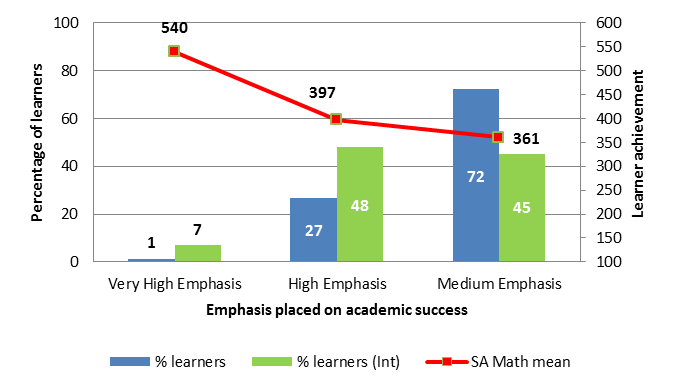
Challenges facing teachers
Teachers were asked to respond to eight statements related to challenges which they face[1]. There is a clear association between the challenges which teachers face and learners’ mathematics achievement. Learners attending schools where teachers are faced with fewer challenges obtain higher mathematics scores on average than learners attending schools where teachers are faced with many challenges. Sixty percent of South African learners attended schools where teachers were faced with some challenges. The percentage of schools facing many challenges in South Africa is double that of the international average.
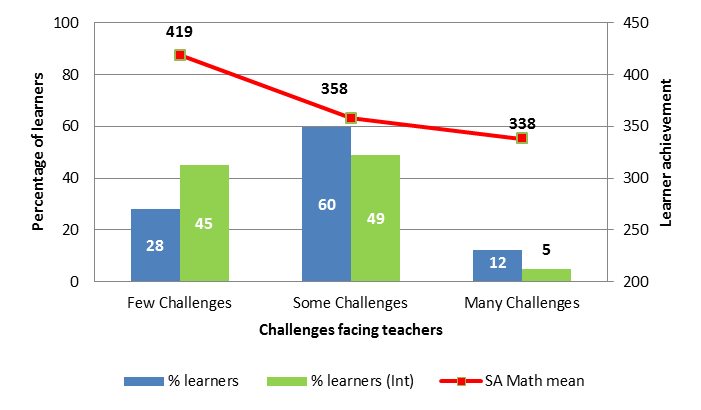
Bullying
A strong correlation exists between incidences of bullying and learners’ mathematics achievement, in that learners who do not experience bullying at school score on average 68 TIMSS points more than learners who are exposed to bullying. In South African schools, 17% of Grade 9 learners are bullied on a weekly basis which is double that of the international average.
The chances of being bullied regularly were higher for boys than girls, especially among lower performing learners. The difference between boys and girls being bullied became smaller as mathematics achievement improved. This shows that there is a relationship between mathematics achievement and bullying, but we do not know the direction of this relationship.
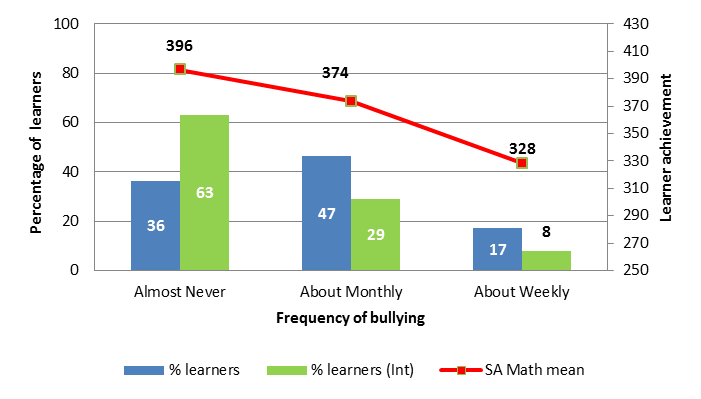
School discipline
Principals were asked to respond to a series of statements relating to aspects of discipline in their schools. The graph below shows the percentage of responses for 3 categories: schools with hardly any discipline problems, schools with minor problems, and schools with moderate to severe problems. Furthermore, the graph shows a comparison between the South African and international averages. The percentage of learners attending schools with severe discipline problems is three times higher in South Africa than the international average. A correlation exists between school discipline and learners’ mathematics achievement, with a score difference of 64 points between learners attending schools with hardly any problems and those attending schools with severe discipline problems.
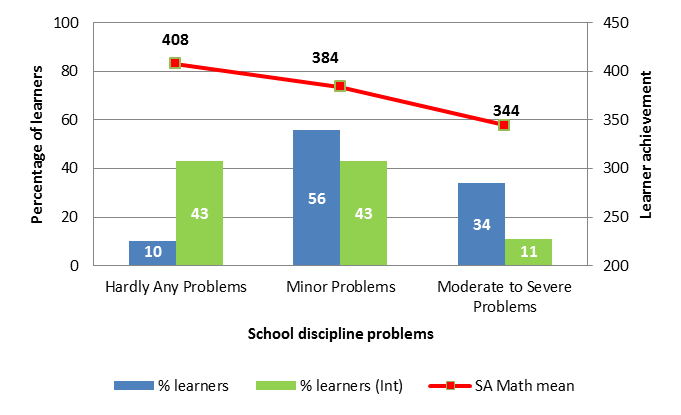
Safe and orderly schools
The safe and orderly measurement scale was composed of eight statements that teachers were asked to respond to[2]. This scale showed the smallest achievement gap (49 points on average) between learners attending schools which are considered to be very safe and orderly and those that are not safe and orderly. Compared to the international average (8%), schools in South Africa are almost three times less safe and orderly (22%).
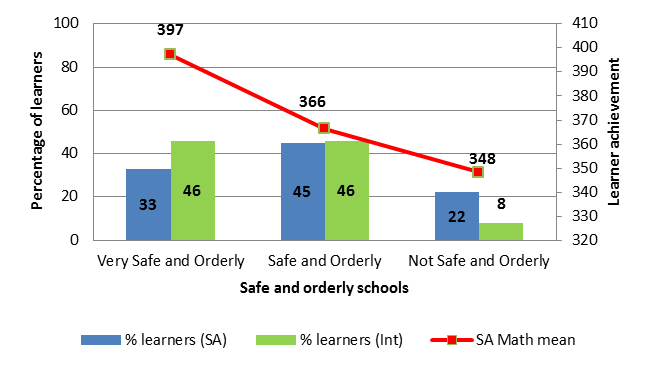
Concluding remarks
It is thus clear that learners that perform well attend schools that: place a very high emphasis on academic success; have teachers who are faced with few challenges; have low levels of bullying and have very few problems with issues of discipline and safety. These schools would likely be regarded as having a healthy school climate where all participants (learners, parents, teachers and school management) have a clear understanding of the ethos of the school and have a sense of belonging. For the majority of schools in South Africa to reach this point, academic success needs to be emphasised in all schools, and challenges related to teaching, discipline and safety need to be addressed. In addition, a proactive rather than a reactive approach to bullying needs to be taken.
| Author: Lolita Winnaar, Senior Research Manager Education and Skills Development research programme of the HSRC |
| [1] There are too many students in the class; I have too many materials to cover in class; I have too many teaching hours; I need more time to prepare for class; I need more time to assist individual learners; I feel too much pressure from parents; I have difficulty keeping up with all the changes to the curriculum; I have too many administrative tasks.[2] This school is located in a safe neighbourhood; I feel safe at this school; This school’s security policy and practices are sufficient; The students behave in an orderly manner; The students are respectful of their teachers; The students respect school property; This school has clear rules about student conduct; This school’s rules are enforced in a fair and consistent manner |
